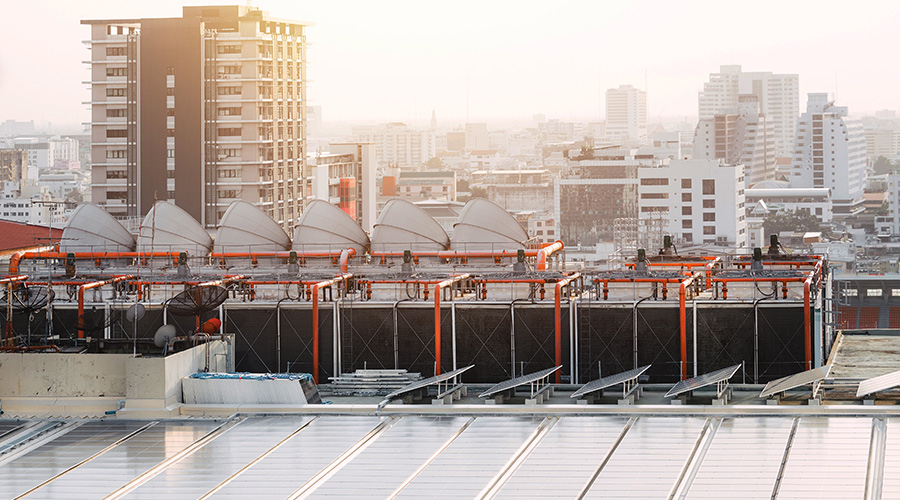Exploring New Paths
Faced with rising utility costs, facility executives are under increasing pressure to reduce energy use without harming indoor environmental quality and occupant satisfaction. Fortunately, HVAC innovations can help achieve this goal.
When it comes to selecting HVAC systems and components, facility executives have never had as many options as they do today.
Properly applied, these technologies can reduce energy use, improve system performance and reduce maintenance requirements. But not all technologies are well-suited for all applications. Failure to match the technologies to the needs of the application can hamper system performance, increase complaints from occupants, and increase both maintenance requirements and energy use.
While some new technologies, such as those that support interoperability, have received widespread attention, the technologies described below are not as widely known yet offer equally important benefits.
Ductless Split Systems
Ductless split systems are not really new. They have been widely applied in residential facilities and as supplemental units in commercial and institutional facilities for years. What is new is that their use as primary systems in commercial and institutional facilities is becoming more widely accepted today.
A ductless split system is a heating and cooling system that can be used to serve a single area or as many as five zones within a facility. The system consists of an outdoor condensing unit that is connected by refrigerant lines to an indoor, non-ducted air handler. The units are similar in design and operation to window air-conditioning units, except that the indoor and outdoor portions of the system are physically separated. Most of the current systems use air-to-air heat pumps.
One of the reasons why the systems are growing in popularity is their flexibility. Without a bulky interior unit, ductless split systems can be installed practically anywhere. The interior portion of the unit can be mounted on the ceiling or on the wall. The only connections needed between the interior and exterior portions of the system are the refrigerant lines, and these require only a small hole cut through the wall.
Another factor contributing to the growing acceptance of the systems is their quiet operation. In any air-conditioning system, the biggest source of noise is the unit’s compressor. The compressor in ductless split systems is isolated from the other parts of the system and can be located away from the conditioned space, resulting in quiet operation.
Ductless split systems offer financial benefits as well. First costs are significantly lower than for ducted systems, and split systems are energy efficient. One energy advantage: In conventional ducted systems, it is not uncommon to find that anywhere from 10 to 20 percent of the airflow in the system’s ducts is lost through leakage. With no ducts, this loss is reduced to zero.
Ductless split systems can be used in a wide range of commercial and institutional applications. They are well-suited for applications that undergo frequent reconfigurations because there is no ductwork that must be moved or replaced. However, facility executives should be aware that the units do not supply outdoor air to the conditioned space.
Oil-Free Compressors
Conventional air-conditioning compressors require oil to lubricate internal bearings. Using oil within the chiller system can reduce overall system efficiency if the oil is carried to the system’s evaporator and condenser by the refrigerant. Once there, the oil tends to coat internal surfaces. This film of oil interferes with the rate of heat transfer, thus reducing the overall energy efficiency of the unit.
Compressors that use oil also require maintenance programs to test both the quantity and the quality of oil in the system. If the oil becomes contaminated for any reason, it has to be changed or the internal components of the compressor may be damaged.
Even with the best maintenance programs, oil does not totally eliminate friction. With time and use, friction causes wear on bearings and gears, eventually resulting in the need to overhaul the unit.
The new generation of oil-free compressors eliminates the problems of oil, friction and wear by eliminating conventional lubricated bearings. In an oil-free compressor, the impellers and the rotating shaft form a single moving part that is suspended on magnetic bearings. With no mechanical bearings, oil-free compressors promise improved reliability and reduced maintenance. The units are currently available in sizes ranging from 60 to 160 tons.
Oil-free compressors also offer the advantage of high operating efficiency. A typical centrifugal compressor that is relatively new and has been well maintained has an operating efficiency between 0.50 and 0.75 kW per ton. Oil-free compressors provide operating efficiencies between 0.35 and 0.55 kW per ton. Where they have been installed as replacements for centrifugal chillers, facility executives have reported achieving seasonal improvements in operating efficiencies of 30 percent.
Variable frequency drives used in oil-free compressors account for much of the efficiency improvement. This allows the compressors to maintain near full-load operating efficiency over a wide range of building loads. It also allows the compressors to operate with building loads as low as 10 percent of their full-load rating.
The digital control system offers another advantage. When a conventional air-conditioning compressor is started, it can have an inrush current of several hundred amps, depending on the size of the compressor. This inrush current results in heating of the compressor’s electrical contacts and wiring. The digital control system for oil-free compressors performs what is called a soft start by limiting the inrush current to approximately two amps. The lower inrush current reduces strain and heating in electrical components in the compressor and throughout the facility’s electrical system.
Oil-free compressors are well-suited for applications where centrifugal and other chillers were used in the past. Their small size and low weight allows multiple units to be installed as a replacement for a single large conventional chiller.
This use of multiple chillers offers the additional advantages of allowing staging of chillers to meet load requirements. Staging provides an energy gain, while the use of multiple chillers offers several levels of backup.
VRF Systems
Variable refrigerant flow (VRF) systems, also known as variable refrigerant volume systems, match the flow rate on the refrigerant from the compressor to the facility’s heating or cooling load.
There are two basic versions of this relatively new type of system. In one version, refrigerant is circulated between a common outdoor unit and several indoor units, each supplying heating or cooling to a particular zone within the facility. Each of the units connected to the system can provide heating or cooling to that particular zone. A compressor controlled by a variable frequency drive regulates refrigerant flow in the system. As the heating or cooling load increases, the variable frequency drive increases the speed of the compressor, increasing the flow of refrigerant. This version of the VRF system is well-suited for small- to medium-sized facilities where individual zones have varying requirements for heating or cooling.
The second version of the VRF system is better suited for large facilities, particularly those where heating may be required in some areas while cooling is required simultaneously in others. In this version of the system, the major components include water-source heat pumps installed in each of the building’s zones, a plate and frame heat exchanger, piping to circulate water between the heat pumps and the heat exchanger, a cooling tower, and supplemental boilers.
During the cooling season, heat from each zone’s heat pump is transferred through the heat exchanger to the cooling tower where it is rejected to the atmosphere. During the heating season, heat is supplied to the individual zone heat pumps by the water circulation loop heated by the central boilers. During both seasons, each individual zone heat pump can be operated in either the heating or cooling mode.
This use of a circulation loop allows heat to be transferred around the building to where it is needed. For example, during a sunny day with cool temperatures, the system essentially transfers heat from the portion of the building that needs cooling to the portion that needs heating. It also allows heat to be transferred from interior zones and zones with high internal heat loads that require cooling to those zones requiring heating.
Both versions of the VRF system provide excellent comfort levels, particularly in buildings where heating and cooling loads vary significantly from one portion of the building to another. The systems can be used in both new construction and existing facilities. Using a relatively small cooling tower instead of multiple condensing units allows the system to be used in applications where it is difficult or impossible to place a large number of condensing units or where the noise level generated by multiple condensing units is unacceptable. With no need for a large central chiller, the system can be installed in facilities with limited space for equipment.
TECHNOLOGY TIP
VFDs Can Optimize Efficiency
Most HVAC systems and components are sized for peak loads. Peak loads, however, typically occur less than 2 percent of the time that the system is operated. Unfortunately, the peak operating efficiency for most HVAC systems and components occurs at or near peak load conditions, and falls off rapidly with decreased load. This means that for nearly 98 percent of their operating time, these systems and components are operating at less than peak efficiency, often much less.
For example, a centrifugal chiller that offers a full-load operating efficiency of 0.5 kW per ton may have that efficiency fall to 0.75 kW per ton at 75 percent load. At even smaller loads, the efficiency will fall even further. Similar efficiency decreases are experienced in fan and pump systems.
A variable frequency drive (VFD) can be used to improve the operating efficiency of HVAC electric drives when they are operating at part load. A VFD operates by varying the voltage and frequency of the power supplied to an HVAC electric drive. As the load on the equipment decreases, the VFD controls reduce the voltage and frequency, slowing the drive. The result is that the HVAC electric drive continues to operate at near full-load efficiency over a wide range of actual loads. Units are available with capacities ranging as high as 500 horsepower.
A side benefit of the drives is that they can be used to soft start equipment. When a typical HVAC motor is started, it produces a high inrush current that results in heating of the motor and electrical contacts, and strain on the facility’s electrical system. By controlling the power’s voltage and frequency during startup, a VFD system can significantly reduce the inrush current and its impact on both the equipment and the facility’s electrical system.
One problem that plagued VFD systems in the past was that they produce electrical harmonics that could be spread through portions of the facility’s electrical system. These harmonics could lead to overheating of motors, higher currents in transformers and distribution equipment, and failure of sensitive electronic equipment including computers and telecommunications equipment. The latest generation of VFD systems, through redesign of the electronics and the addition of electrical filtering, has practically eliminated the generation of harmonics.
|
James Piper, PhD, PE, is a writer and consultant who has more than 25 years of experience in facilities management. He is a contributing editor for Building Operating Management.
Related Topics:











